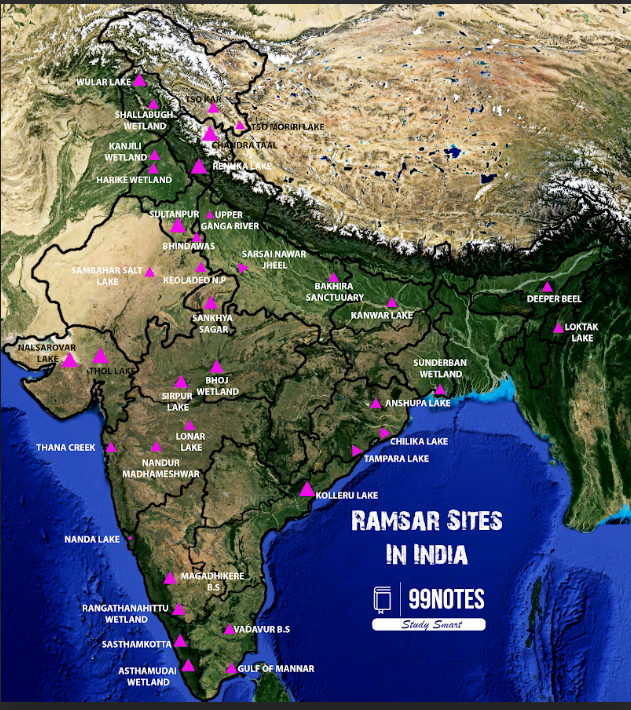6 August 2024 : Daily Current Affairs
1. On doorstep delivery of alcohol
- 1. On doorstep delivery of alcohol
- 2. Why was a customs duty hike imposed for lab chemicals?
- 3. How time has been kept throughout history: from sundials to atomic clocks
- 4. Navigating Turbulence: India’s Strategic Response to Sheikh Hasina’s Fall and Its Regional Implications
- 5. SIT Report Reveals Major Lapses in Investigations of Tiger Deaths in Madhya Pradesh
- 6. Coral Bleaching
- 7. Bhoj Wetland
- Prelims Facts
- 1. WCC tag gives rare chance for Kashmir craftsmen to trace their roots, enhance skills
- 2. Gene that helps race horses manage BP could help human athletes, too
- 3. Coal India eyes lithium in Chile
- 5. China’s CMOC and other miners of Congolese copper seek LME listing
- 6. Lok Sabha passes Bill allowing Centre to draw from Consolidated Fund for 2024-25
- 7. Majority of Rural Youth in India Seek Job Change, Shun Agriculture as Career: Report
- 8. National Coastal Scheme
(Source – The Hindu, International Edition – Page No. – 10)
| Topic: GS1 – Indian Society |
| Context |
|
Introduction: Rise in Alcohol Consumption in India
- Several Indian states, including Delhi, Karnataka, Haryana, Punjab, Tamil Nadu, Goa, and Kerala, are considering allowing doorstep delivery of alcohol through platforms like Swiggy, BigBasket, and Zomato.
- India has witnessed a steady rise in alcohol consumption, with recorded per capita consumption increasing from 1.6 litres in 2003-2005 to 5.5 litres in 2016-2018.
- India is the sixth-largest alcohol market globally, with $52 billion in revenue, and there were about 16 crore alcohol users in the 10-75 year age group in 2018.
Reasons for Doorstep Delivery
- Revenue Generation: Excise taxes on alcohol sales contribute significantly to the revenue of Central and State governments, making up to a quarter of all revenue generated for some states.
- Reduction in Drunk-Driving Incidents: Doorstep delivery could potentially reduce drunk-driving incidents, which account for 6-48% of fatal road traffic accidents in India.
- Safety for Women Consumers: Doorstep delivery might provide a safer option for women consumers, allowing them to access alcohol without social stigma and reducing on-premise violence against women.
Arguments Against Doorstep Delivery
- Economic Costs vs. Benefits: Studies indicate that the costs due to alcohol use exceed the economic benefits from alcohol sales in India.
- Behavioural Assumptions: The assumption that people will change their drinking and socialising behaviours due to doorstep delivery requires concrete evidence.
- Increased Consumption: Availability of alcohol on-demand can lead to increased consumption, binge drinking, and associated harms.
- Questionable Impact on Drunk-Driving: While doorstep delivery might reduce drunk-driving incidents, other evidence-based policies like sobriety checkpoints and increased public transport options could be more effective.
Health and Social Effects of Alcohol Consumption
- Health Risks: Alcohol is a carcinogen and is linked to at least seven types of cancers, as well as increased risks of injuries, substance abuse, mental illnesses, diabetes, liver disease, heart diseases, and chronic kidney diseases.
- Inter-Partner Violence: Male alcohol misuse is associated with increased risk and severity of domestic violence.
- Economic Impact: Treatment of diseases and injuries related to alcohol is expected to cost India over ₹3 lakh crore between 2011 and 2050, with productivity losses raising this to ₹121.3 lakh crore. Excise tax revenue is projected to cover only a fifth of these losses.
The Alcohol Industry and Policy Challenges
- Industry Influence: The alcohol industry is known for intense lobbying and efforts to weaken health warning labels. It targets low- and middle-income countries, viewing them as emerging markets.
- Policy Variation: Alcohol-use policies in India are largely determined by individual states, leading to wide variation in policy framing and implementation.
Recommendations for Government Action
- Policy Measures: Governments can mitigate harms through public health approaches, such as restricting availability and marketing of alcohol, raising taxes, enforcing drunk-driving laws, and investing in psychosocial treatments for alcohol-use disorders.
- Impact Monitoring: If doorstep delivery is implemented, governments should collaborate with health departments to monitor its impact on alcohol consumption. Accurate data sharing by service companies is crucial for understanding the health and economic burden.
- Adjustments Based on Evidence: Policies should be revised if evidence indicates increased harm from doorstep delivery.
| Practice Question: Analyse the potential impacts of introducing doorstep alcohol delivery in India. Discuss the associated benefits and risks, including economic, health, and social implications, and propose measures to mitigate potential negative effects. (150 Words /10 marks) |
2. Why was a customs duty hike imposed for lab chemicals?
(Source – The Hindu, International Edition – Page No. – 10)
| Topic: GS2 – Governance. |
| Context |
|
Introduction: Customs Duty Hike on Laboratory Chemicals
- The Finance Ministry withdrew a proposed customs duty hike on imported laboratory chemicals after significant objections from scientists.
- Laboratory chemicals are crucial for experimental research and medical diagnostics. They include oxidizers, corrosive acids, and compressed gases, as well as related instruments like funnels, beakers, and test tubes.
Definition and Importance of Laboratory Chemicals
- Definition: Laboratory chemicals are defined by the Customs Department as chemicals (organic or inorganic) imported in packages not exceeding 500 grams or 500 milliliters, identifiable by their purity and other features, and meant solely for laboratory use.
- Role in Research and Diagnostics: These chemicals are essential for experimental research and medical diagnostics. They are often niche products that can be expensive and are scrutinised during import due to their potential hazards.
Issue with Customs Duty Hike
- Duty Increase: The Budget documents released on July 23 proposed a steep hike in Basic Customs Duty (BCD) on these chemicals from 10% to 150%.
- Impact on Costs: The increase led to a significant rise in the cost of chemicals, with a batch that previously cost ₹1,00,000 now costing ₹2,50,000. There was also a 25% hike on plastic components used in laboratories.
- Reactions from Scientists: Scientists from publicly funded research laboratories reported the hike and sought clarification, suspecting it to be a “misprint.” Senior scientists reached out to the Ministry of Science and Technology, but the issue falls under the jurisdiction of the Ministry of Finance and Commerce.
Need for Imported Chemicals
- Local Manufacturing Limitations: While India is a major manufacturer and exporter of chemicals, there is insufficient local demand for niche chemicals, which requires substantial capital investments to produce.
- Replication of Experiments: Imported chemicals are often necessary for replicating experiments conducted abroad, as exact materials used in foreign research are required.
Resolution of the Issue
- Reason for Hike: The customs department implemented the hike to curb imports of ethanol misclassified as ‘laboratory chemicals’ to avoid the high duty rate. Ethanol used in alcohol manufacture and denatured ethanol (used in laboratories) are different. Denatured ethanol is typically produced locally and doesn’t usually need to be imported.
- Revised Notification: Following the backlash, the Finance Ministry reverted to the original duty rate. However, imported laboratory chemicals must now be accompanied by a letter confirming they are for laboratory use only and not for commercial trading.
Conclusion
- Temporary Challenges: The proposed customs duty hike led to confusion and potential delays in procuring essential laboratory chemicals. The issue has been partially resolved with the return to the original duty rate but requires additional documentation for imports.
- Ongoing Concerns: The situation highlighted the dependency on imported chemicals for research and the challenges of balancing customs regulations with scientific and medical needs.
| Practice Question: Discuss the implications of the proposed customs duty hike on imported laboratory chemicals for scientific research and medical diagnostics in India. How did the Finance Ministry address the concerns raised by scientists, and what steps should be taken to ensure the effective procurement of essential research materials? (250 Words /15 marks) |
3. How time has been kept throughout history: from sundials to atomic clocks
(Source – The Hindu, International Edition – Page No. – 11)
| Topic: GS3 – Science and Technology |
| Context |
|
Understanding Clocks and Their Evolution
What is a Clock?
- Definition: A clock measures and displays the passage of time.
- Components: Modern clocks typically include a power source, resonator, and counter.
- Function: Clocks track time by observing repetitive events. For instance:
- Quartz Crystals: Common in modern clocks, they vibrate at a fixed frequency.
- Natural Events: Historically, sundials used sunlight, water clocks relied on filling vessels, and hourglasses used sand.
Mechanical Clocks
- Early Developments: Before the Middle Ages, water clocks evolved with additional mechanisms like gear wheels and pulleys.
- 13th Century Innovation: The verge escapement mechanism was a significant breakthrough, introducing mechanical clocks.
- Verge Escapement: Included an escape wheel and balance wheel, allowing fixed interval movement and oscillation.
- 15th-18th Centuries: Spring-driven clocks replaced weights with coiled springs, improving accuracy.
- Fusee Mechanism: Ensured uniform force delivery from the spring.
- Pocket Watches: Developed through the combination of balance spring and balance wheel.
- Mid-17th Century: Christiaan Huygens invented the pendulum clock, using a pendulum’s swings to measure time.

Impact on Shipping
- Longitude Determination: Accurate clocks were essential for calculating longitude at sea, alongside latitude and altitude.
- 1761 Marine Chronometer: John Harrison developed a clock unaffected by a ship’s motion, gravity, or temperature, winning the British government’s longitude prize.
Modern Clock Technologies
- Electric Clocks: Emerged in the 19th century, using batteries or electric motors instead of mechanical components. They improved efficiency with attached weights or springs.
- Quartz Clocks:
- Operation: Utilise a quartz crystal as the resonator, which oscillates due to the piezoelectric effect when electrical signals are applied.
- Mechanism: The crystal’s oscillations are counted and converted into time measurements.
- Advantage: Quartz clocks are affordable, reliable, and became widespread in the mid-20th century.

- Atomic Clocks:
- Operation: Use lasers and atomic resonators. Atoms absorb energy and emit radiation at specific frequencies.
- Caesium Atomic Clocks: Employ caesium-133 atoms, with a frequency of 9,192,631,770 Hz for measuring time.
- Function: The counter records the frequency of radiation to determine time.
- Accuracy: Caesium clocks gain or lose a second once in 20 million years.
- Optical Clocks: Next-generation clocks use radiation in the optical range (hundreds of terahertz) with strontium or ytterbium atoms. They are highly stable, losing or gaining a second only in 10 billion years.
Future Developments
- Nuclear Clocks:
- Concept: Utilise atomic nuclei as resonators instead of entire atoms.
- Advantages: Nuclei, being more isolated within atoms, may offer greater stability.
- Recent Progress: Since April 2024, advancements include:
- Thorium-229 Nuclear Clock: Researchers developed a laser to excite thorium-229 nuclei and linked it with optical clocks.
- Frequency: The de-excitation emission frequency is 2,020 terahertz, promising ultra-high precision.
4. Navigating Turbulence: India’s Strategic Response to Sheikh Hasina’s Fall and Its Regional Implications
(Source: Indian Express; Section: Cover page; Page: 01)
| Topic: GS2 – International Relations – Bilateral Relations |
| Context: |
|
Analysis of News:
Political and Diplomatic Challenges
- India faces significant political and diplomatic challenges in dealing with the fallout from the fall of Sheikh Hasina, which could destabilize the geopolitical landscape of the subcontinent.
- This situation raises five key questions for Indian state.
Standing by Friends
- India must demonstrate its ability to stand by its allies. Although India ensured Hasina’s safety during the protests in Dhaka, it failed to protect key allies in the past, such as during the assassination of Hasina’s father, Mujibur Rahman, in 1975, and President Najibullah of Afghanistan in 1992.
- Maintaining credibility requires balancing support for Hasina with the need to engage with her opponents.
Engagement with the Opposition
- India’s close identification with Hasina poses a risk as her popularity declines.
- Delhi needs to distance itself from Hasina and build relationships with key opposition figures to manage the transition and maintain stability in Bangladesh.
External Influences
- India must anticipate attempts by Pakistan, China, and other regional players like Turkey to exploit the situation in Dhaka. Cooperation with international partners such as the US, UK, Europe, and Gulf countries will be crucial in ensuring a peaceful transition and economic stabilization of Bangladesh.
Reassessing Historical Narratives
- India should avoid romanticizing the 1971 liberation of Bangladesh and recognize the country’s divided historical perspectives.
- Engaging with anti-liberation forces based on mutual long-term interests is essential for maintaining strategic relations without being tied down by historical narratives.
Recognizing Neighboring Agency
- Indian foreign policy should acknowledge that neighboring countries have their own political dynamics and agency.
- Strategic patience, commitment to commerce, and overcoming the legacies of Partition are necessary for building robust relations with a changing Bangladesh.
Refer to Indo-Bangladesh Relation.
| Practice Question: Analyze the strategic challenges India faces in the wake of a potential political upheaval in Bangladesh following the fall of Sheikh Hasina. (250 words/15 m) |
5. SIT Report Reveals Major Lapses in Investigations of Tiger Deaths in Madhya Pradesh
(Source: Indian Express; Section: Cover Page; Page: 01)
| Topic: GS3 – Environment – Conservation |
| Context: |
|
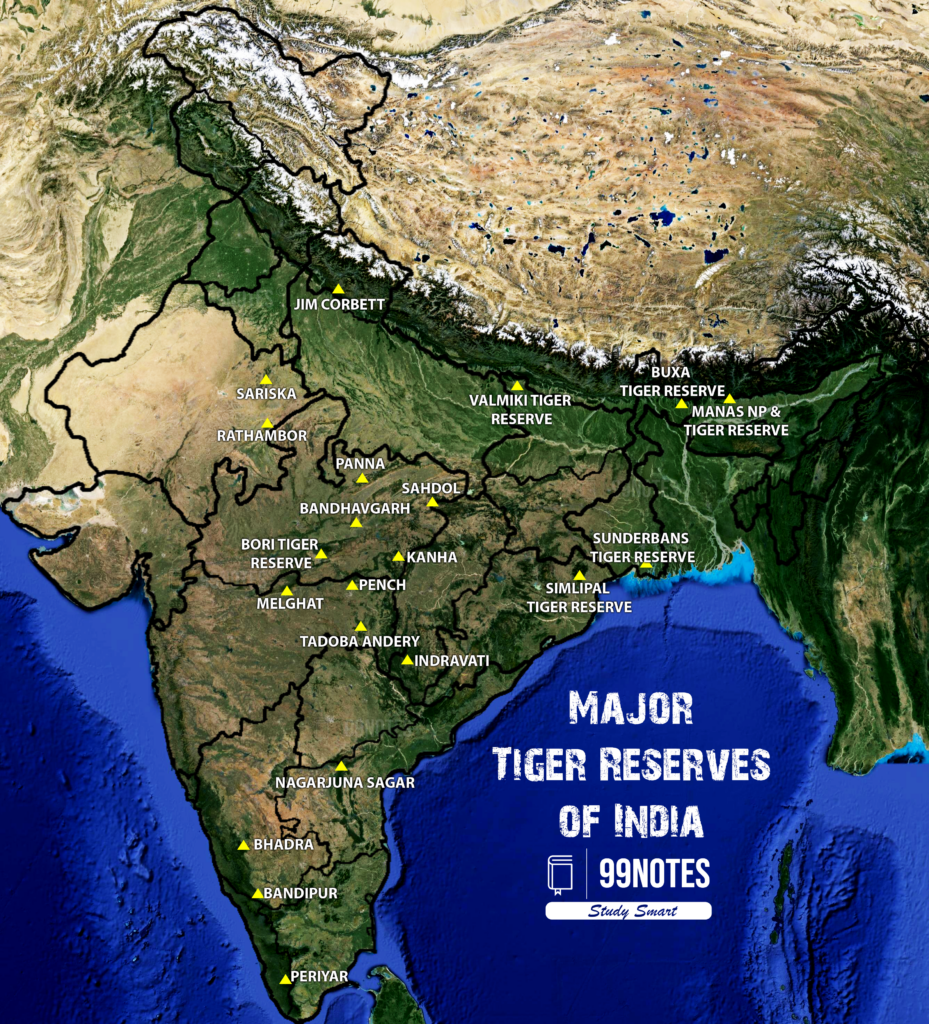
Analysis of News:
Post-Mortem and Medical Negligence
- The SIT identified numerous lapses in post-mortem procedures and medical investigations.
- In many cases, sample collection and sealing were not conducted by qualified Veterinary Officers, affecting the integrity of court cases.
- Autopsies were often performed by veterinarians with no experience in wildlife, leading to unestablished causes of death in several instances.
Specific Case Findings
- May 14, 2021: The skeletal remains of a male tiger were found, with 12 nails and vital organs missing. Inadequate investigation led to the immediate release of suspects.
- August 29, 2021: A tigress found dead in a well was initially attributed to electrocution but later ruled as poaching due to missing body parts.
- January 28, 2022: A tigress with burn marks was incorrectly reported as a victim of infighting, later determined to have been electrocuted.
- September 15, 2023: An adult tiger found with missing body parts was not properly investigated, with post-mortem findings suggesting poaching.
Other Issues
- The SIT report highlighted additional gaps in investigations, such as the absence of scientific methods, failure to call dog squads, and inadequate documentation of evidence.
- Cases often lacked crucial evidence like electric trip data and mobile forensics, further complicating the determination of causes of death.
Recommendations
- The acting Principal Chief Conservator of Forests acknowledged the shortcomings and staff shortages, while the SIT report emphasized the absence of organized poaching gangs but highlighted the need for improved investigative processes.
- Wildlife activists have indicated plans to approach the court to address these issues and ensure better management of tiger conservation efforts.
| What is the Status of Tiger Deaths in India? |
|
|
PYQ: Among the following Tiger Reserves, which one has the largest area under “Critical Tiger Habitat”? (2020) (a) Corbett Ans: (c) |
| Practice Question: Critically examine the findings of the Special Investigation Team (SIT) regarding the investigation into tiger deaths in Madhya Pradesh’s Bandhavgarh Tiger Reserve. Discuss the implications of investigative shortcomings, post-mortem lapses, and medical negligence on wildlife conservation efforts. (250 words/15 m) |
6. Coral Bleaching
(Source – https://pib.gov.in/PressReleseDetail.aspx?PRID=2041457 )
| Topic: GS3 – Environment – Environmental pollution and degradation |
| Context |
|
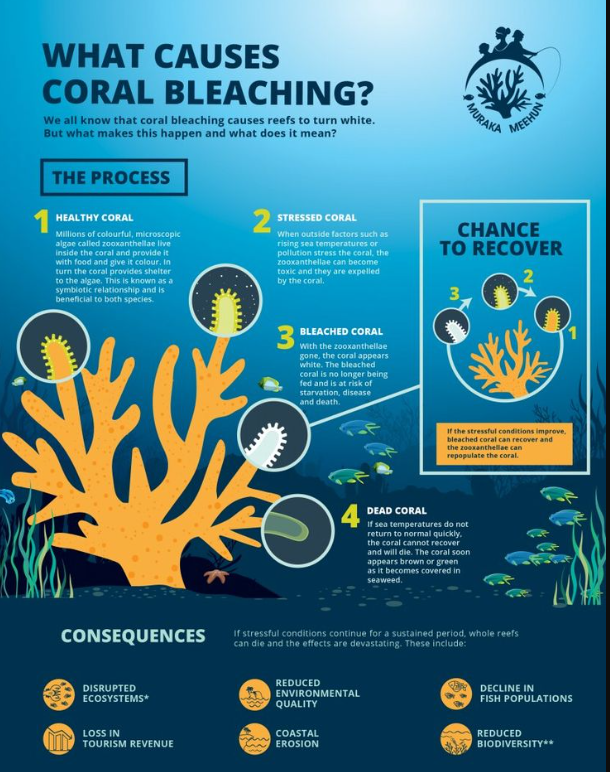
What is Coral Bleaching?
- Definition: Coral bleaching is a phenomenon where corals lose their vibrant colours due to stress factors, primarily elevated sea surface temperatures.
- Visual Effect: Corals turn white or pale as the symbiotic algae (zooxanthellae) living within their tissues are expelled or die.
- Consequences: Prolonged bleaching can lead to coral death, loss of marine biodiversity, and disruption of reef ecosystems.
Factors Responsible for Coral Bleaching
- Global Climate Change: Increase in sea surface temperatures due to global warming is the primary cause.
- Marine Heat Waves: Abnormal rises in sea temperatures over short periods exacerbate bleaching events.
- Pollution: Nutrient runoff, sedimentation, and pollutants can stress coral reefs.
- Overfishing: Depletion of key reef species disrupts ecosystem balance.
- Ocean Acidification: Increased CO2 levels lower ocean pH, affecting coral growth and health.
Status of Coral Bleaching in India
- Recent Government Data: Coral bleaching events were reported in Lakshadweep in March 2024. No significant bleaching was noted in 2023, 2022, 2021, and 2020.
- Regional Observations:
- Lakshadweep: Key area for monitoring and restoration due to significant coral ecosystems.
- Other Regions: Less frequent but potentially impactful events observed in different coastal areas.
Conservation and Management Efforts
- Regulatory Measures:
- Indian Wildlife (Protection) Act, 1972: Coral species listed under Schedule-I for the highest level of protection.
- Coastal Regulation Zone (CRZ) Notification, 2019: Focuses on conservation and management of Ecologically Sensitive Areas (ESAs), including corals. Prohibits harmful developmental activities and waste disposal.
- Government Initiatives:
- Coral Transplantation: Active coral restoration activities conducted in Lakshadweep.
- Integrated Island Management Plan: Provides protection and management strategies for coral reefs.
- Monitoring and Research:
- Zoological Survey of India (ZSI): Monitors coral bleaching through the Long Term Coral Reef Monitoring Program.
- Indian National Centre for Ocean Information Services (INCOIS): Provides bleaching alerts and marine heat wave monitoring since 2011. Conducts coral ecosystem studies in Lakshadweep.
- Central Marine Fisheries Research Institute (CMFRI): Undertakes studies and projects to assess and enhance the resilience of coral reefs.
Ways to Avoid Coral Bleaching
- Reduce Carbon Emissions: Implementing policies and practices to cut greenhouse gas emissions.
- Promote Renewable Energy: Transition to clean energy sources.
- Reduce Runoff: Manage agricultural and industrial waste to minimise nutrient runoff
- Waste Management: Proper disposal and treatment of waste to prevent coastal pollution.
- Regulate Fishing: Enforce sustainable fishing practices and protect key reef species.
| Practice Question: Discuss the causes and consequences of coral bleaching in India. Evaluate the effectiveness of current conservation measures and suggest additional strategies to mitigate coral bleaching. (150 Words /10 marks) |
7. Bhoj Wetland
(Source – https://pib.gov.in/PressReleseDetail.aspx?PRID=2041456 )
| Topic: GS3 – Environment – Conservation |
| Context |
|

Bhoj Wetland Status:
- The Madhya Pradesh government has reassured that Bhoj Wetland in Bhopal is currently secure and is not at risk of being removed from the Ramsar Convention’s list of wetlands of international significance. Conservation efforts and regulatory measures continue to protect its status and ecological health.
National Conservation Initiatives:
- National Plan for Conservation of Aquatic Ecosystems (NPCA): Centrally sponsored scheme covering wastewater treatment, shoreline protection, lake development, desilting, stormwater management, and more.
- Activities: Includes bioremediation, biodiversity conservation, education, and community participation.
Ramsar Sites Added (Last Three Years):
| State | Wetlands |
| Bihar | Nagi Bird Sanctuary, Nakti Bird Sanctuary (2023) |
| Gujarat | Wadhvana Wetland, Thol Lake Wildlife Sanctuary, Khijadia Wildlife Sanctuary (2021) |
| Goa | Nanda Lake (2022) |
| Haryana | Sultanpur National Park, Bhindawas Wildlife Sanctuary (2021) |
| Jammu & Kashmir | Hygam Wetland Conservation Reserve, Shallbugh Wetland Conservation Reserve (2022) |
| Karnataka | Ranganathittu Bird Sanctuary, Ankasamudra Bird Conservation Reserve, Aghanashini Estuary, Magadi Kere Conservation Reserve (2023) |
| Madhya Pradesh | Sirpur Wetland, Sakhya Sagar, Yashwant Sagar (2022) |
| Maharashtra | Thane Creek (2022) |
| Mizoram | Pala Wetland (2021) |
| Odisha | Satkosia Gorge, Tampara Lake, Hirakud Reservoir, Ansupa Lake (2021) |
| Tamil Nadu | 15 sites including Koonthankulam Bird Sanctuary, Vembannur Wetland Complex (2023) |
| Uttar Pradesh | Haiderpur Wetland, Bakhira Wildlife Sanctuary (2021) |
| Ramsar Convention |
|
Key Objectives:
Implementation: Supported by national policies, site management plans, and international collaboration. |
Prelims Facts
1. WCC tag gives rare chance for Kashmir craftsmen to trace their roots, enhance skills
(Source – The Hindu, International Edition – Page No. – 2)
| Context |
|

World Crafts Council (WCC):
- Establishment: Founded in 1964 by Aileen Osborn Webb, the World Crafts Council (WCC) is a non-profit, non-governmental organisation that aims to promote and preserve traditional crafts worldwide.
- Objective: The primary objective of the WCC is to strengthen the status of crafts as a vital part of cultural and economic life, encouraging the growth and sustainability of crafts globally.
- Membership: The WCC is composed of five regions: Africa, Asia Pacific, Europe, Latin America, and North America. Each region consists of various countries and craft organisations.
- World Craft Cities: The WCC designates cities with exceptional commitment to crafts as “World Craft Cities,” recognizing their efforts in preserving craft traditions.
- UNESCO Affiliation: The WCC works closely with UNESCO and other international bodies to advocate for the cultural and economic importance of crafts.
- Impact: By fostering international cooperation and networking among artisans, the WCC helps safeguard cultural heritage and promote sustainable development in the craft sector.
2. Gene that helps race horses manage BP could help human athletes, too
(Source – The Hindu, International Edition – Page No. – 7)
| Context |
|
Analysis of the news:
- Haplotype Identification: Researchers at the Swedish University of Agricultural Sciences identified a specific haplotype, referred to as EPH, that is associated with superior racing performance in horses.
- Genomic Location: The EPH haplotype is located on chromosome 22 in horse cells and corresponds to chromosome 20 in humans.
- Genetic Influence: This haplotype functions as an enhancer, impacting the expression of genes related to cardiovascular function.
- Human Chromosomal Location: The corresponding gene sequence in humans is located on chromosome 20 and interacts with blood pressure-related promoters.
- Human Health Implications: Understanding the EPH haplotype’s function aids in uncovering the genetic basis of blood pressure regulation in humans.
- Cardiovascular Research: The findings provide insights into the biological mechanisms underlying cardiovascular health and disease, potentially informing new treatment strategies.
- Athletic Performance: The gene’s role in regulating blood pressure during physical activity offers a genetic perspective on elite human athletic performance.
3. Coal India eyes lithium in Chile
(Source – The Hindu, International Edition – Page No. – 13)
| Context |
|
Analysis of the news:

- State-run Coal India (CIL) is exploring opportunities to extract lithium from Chile’s salt flats.
- CIL has expressed interest to the Chilean government and submitted a response to Chile’s request for information (RFI) regarding lithium projects.
- The company has signed non-disclosure agreements with international firms to assess the feasibility of investing in lithium projects.
- Chile holds about 50% of the world’s viable lithium reserves and is the second-largest global producer, contributing around 36% of global lithium trade.
- In March 2024, Chile’s government announced new private sector investment opportunities in lithium exploration.
- Investors can either partner with existing state-owned entities or make private investments, depending on the salt flat or business type.
- Chile’s National Lithium Strategy includes special contracts for exploration and extraction of lithium.
5. China’s CMOC and other miners of Congolese copper seek LME listing
(Source – The Hindu, International Edition – Page No. – 13)
| Context |
|
Copper reserves in DRC:
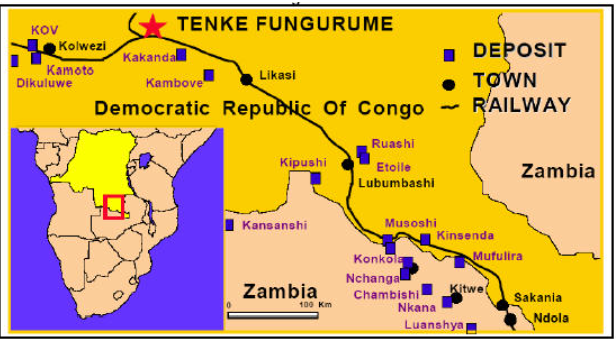
- The Democratic Republic of Congo (DRC) is the world’s second-largest copper producer.
- Copper Reserves: DRC holds significant copper deposits, particularly in the Copperbelt region, which includes key mines like Tenke Fungurume and Kisanfu.
- Annual Production: The country produced 2.7 million tonnes of copper last year, representing 12% of global supply.
- LME Registration: Efforts are underway to register DRC copper for London Metal Exchange (LME) contracts to enhance financing and market presence.
- Ethical Concerns: Issues include artisanal mining associated with child labour and environmental impacts, addressed by certifications like the Copper Mark.
6. Lok Sabha passes Bill allowing Centre to draw from Consolidated Fund for 2024-25
(Source: Indian Express; Section: In Parliament; Page: 07)
| Context |
| The article reports on the Lok Sabha‘s approval of the Appropriation (No. 2) Bill, 2024, authorizing government spending for the fiscal year 2024-25. |
Analysis of News:
Consolidated Fund of India (Article 266)
- Consolidated Fund of India is an account in which all the revenues received by the central government by way of direct and indirect taxes, borrowings and receipts from loans, repayments of loans are credited.
- All the central government expenditures, except the exceptional items which are met from Contingency fund or the Public Account of India, are made from this fund, though only after obtaining parliamentary approval.
Contingency Fund of India (Article 267)
- Contingency Fund of India is a special fund from which the President of India can make advances to meet urgent unforeseen expenditures in case of any contingency.
- It has a fixed corpus of 500 crores. The government will have to obtain authorization from the parliament later on.
Public account of India [(Article 266 (2)]
- Public account of India is an account in which all the public money (other than those covered under the Consolidated Fund of India) received by or on behalf of the Indian government are credited.
- The government does not need parliament’s permission to make advances from this account. Such payments are mostly in the nature of banking transactions.
7. Majority of Rural Youth in India Seek Job Change, Shun Agriculture as Career: Report
(Source: Indian Express; Section: Economy; Page: 15)
| Context: |
|
Analysis of News:
Key findings include:
- Agriculture and self-employment are no longer seen as aspirational by many rural youths due to low productivity and insufficient profits.
- Many youth prefer starting small businesses or seeking salaried jobs in the public or private sectors.
- 90% of male and 50% of female respondents interested in entrepreneurship require seed capital, with minimal demand for full training courses.
- A majority of respondents prefer employment close to their villages, even with a 20-30% lower income, indicating a need to boost local employment opportunities.
- The report underscores the need to make agriculture more attractive through better productivity, technical support, and crop diversification to address the rural employment gap.
8. National Coastal Scheme
(Source – https://pib.gov.in/PressReleseDetail.aspx?PRID=2041455 )
| Topic: GS2 – Governance – Government policie |
| Context |
|
The National Coastal Mission Scheme (NCM):
- Objective: The National Coastal Mission Scheme (NCM) aims to manage and conserve India’s coastal and marine ecosystems under the National Coastal Management Program.
- Components:
- Mangrove and Coral Reef Conservation: Management Action Plan focusing on the preservation of mangroves and coral reefs.
- Research & Development: Initiatives in marine and coastal ecosystems to advance scientific understanding.
- Beach Development: Sustainable development of beaches, including aesthetic and environmental management services.
- Capacity Building & Outreach: Programs to enhance conservation efforts by coastal states and UTs, including beach cleaning drives.
- Implementing Agencies: Managed by State Governments of Coastal States and Union Territory Administrations.
- Funding: ₹7.94 crore released from 2018-19 to 2023-24 for infrastructure, pollution abatement, safety surveillance, and beach cleaning in Andhra Pradesh.
- Related Projects: The Integrated Coastal Zone Management Project (ICZMP) by MoEFCC has contributed to mapping hazard lines, eco-sensitive areas, and sediment cells along India’s coastline.

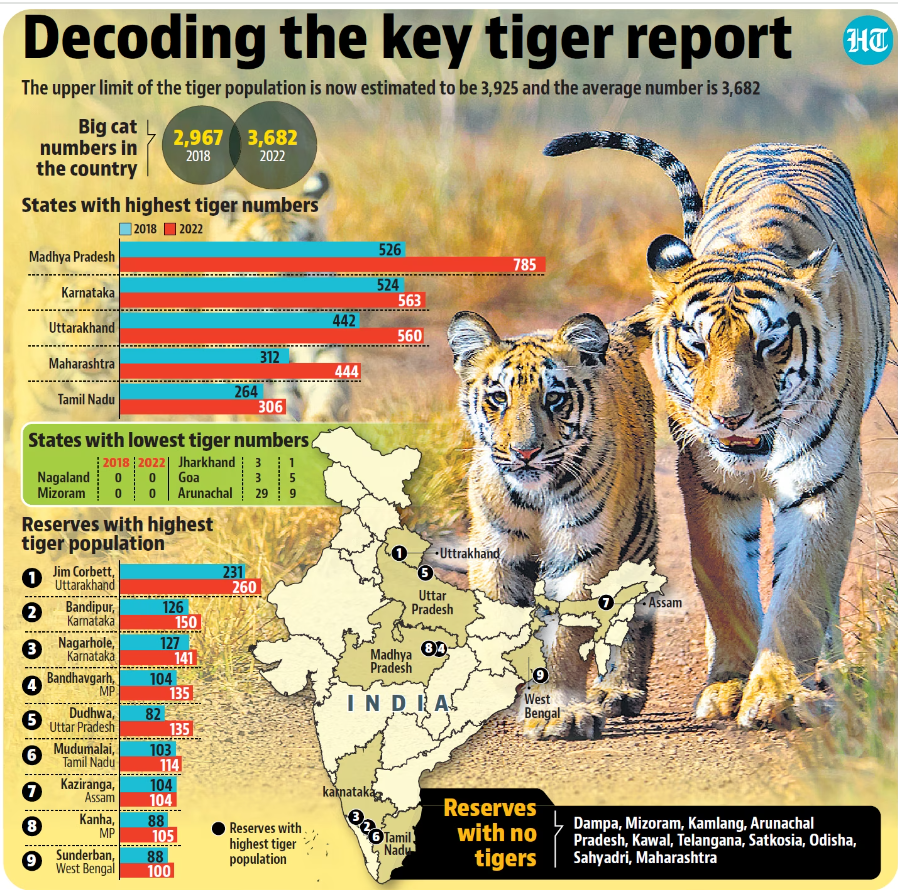 Maharashtra has recorded the highest number of tiger fatalities with 52 deaths, prompting apprehensions regarding the adequacy of conservation measures in the state.
Maharashtra has recorded the highest number of tiger fatalities with 52 deaths, prompting apprehensions regarding the adequacy of conservation measures in the state.